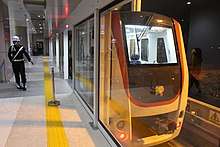Soekarno–Hatta Airport Skytrain
The Soekarno–Hatta Airport Skytrain (Indonesian: Kalayang Bandara Soekarno–Hatta) is the driverless 3.05 kilometres Automated People Mover System (APMS) serves to connect Soekarno-Hatta Airport Terminals 1, 2, 3 and SHIA railway station, free of charge.[1] Skytrain takes 5 minutes from one terminal to another, with 7 minutes needed to get from Terminal 2 to Terminal 3.[2][3]
| Soekarno–Hatta Airport Skytrain | |||||||||||||||||||||||||||||||||||||||||||||||||||||||||||||||||||||
|---|---|---|---|---|---|---|---|---|---|---|---|---|---|---|---|---|---|---|---|---|---|---|---|---|---|---|---|---|---|---|---|---|---|---|---|---|---|---|---|---|---|---|---|---|---|---|---|---|---|---|---|---|---|---|---|---|---|---|---|---|---|---|---|---|---|---|---|---|---|
 Soekarno-Hatta Airport Skytrain used for airport terminals shuttle service | |||||||||||||||||||||||||||||||||||||||||||||||||||||||||||||||||||||
| Overview | |||||||||||||||||||||||||||||||||||||||||||||||||||||||||||||||||||||
| Native name | Kalayang Bandara Internasional Soekarno-Hatta | ||||||||||||||||||||||||||||||||||||||||||||||||||||||||||||||||||||
| Type | Automated people mover (APM) | ||||||||||||||||||||||||||||||||||||||||||||||||||||||||||||||||||||
| Status | Operational | ||||||||||||||||||||||||||||||||||||||||||||||||||||||||||||||||||||
| Locale | Soekarno–Hatta International Airport serving Jakarta | ||||||||||||||||||||||||||||||||||||||||||||||||||||||||||||||||||||
| Stations | 4 | ||||||||||||||||||||||||||||||||||||||||||||||||||||||||||||||||||||
| Operation | |||||||||||||||||||||||||||||||||||||||||||||||||||||||||||||||||||||
| Opened | 17 September 2017[1] | ||||||||||||||||||||||||||||||||||||||||||||||||||||||||||||||||||||
| Owner | Angkasa Pura II | ||||||||||||||||||||||||||||||||||||||||||||||||||||||||||||||||||||
| Operator(s) | Angkasa Pura II | ||||||||||||||||||||||||||||||||||||||||||||||||||||||||||||||||||||
| Rolling stock | Woojin Automated People Mover System | ||||||||||||||||||||||||||||||||||||||||||||||||||||||||||||||||||||
| Technical | |||||||||||||||||||||||||||||||||||||||||||||||||||||||||||||||||||||
| Line length | 3.05 km (1.90 mi) | ||||||||||||||||||||||||||||||||||||||||||||||||||||||||||||||||||||
| |||||||||||||||||||||||||||||||||||||||||||||||||||||||||||||||||||||
Rolling stock

The system uses Airport Automated People Mover System rubber-tyred metro manufactured by state-owned enterprise PT LEN Industri in cooperation with South Korean Woojin Industries.[4] Three train units operate with each train unit consisting of two cars. They are capable to transport 176 passengers in one trip. The train travels at a speed of 60 kilometers per hour and is equipped with automated guide-way transit (AGT) technology.
Stations

There are 4 stations served by Airport Skytrain; Terminal 1, 2 and 3 each has one station. The airport shuttle Skytrain is integrated to SHIA railway station, from where passengers can conveniently travel to–and from–Jakarta city center by Soekarno–Hatta Airport Rail Link.
Skytrain operating schedule is accessible online and through the Indonesia Airport website and smartphone application. All Skytrain stations are equipped with platform screen doors and have plasma screens displaying real-time arrival time of the next train. Skytrain has been operational since 17 September 2017.[5]
Future expansion

The Skytrain will be extended to planned new Terminal 4 and Sky Hub (commercial area) in Phase 2. Then it will be connected to Integrated Building Terminal, Terminal 1, 2 and 3.[6]
References
- Post, The Jakarta. "Soekarno–Hatta International Airport Skytrain is officially launched". The Jakarta Post. Retrieved 2018-05-04.
- "Skytrain Trials at Soekarno Hatta Airport to Begin in Mid August". Tempo. Retrieved 30 August 2017.
- "Skytrain to connect terminals at Soekarno–Hatta Airport". The Jakarta Post. Retrieved 30 August 2017.
- Post, The Jakarta. "Airport skytrain to be operated by crew for first six months". The Jakarta Post. Retrieved 2018-05-04.
- "Skytrain to link with Dukuh Atas in December". The Jakarta Post. Retrieved 18 September 2017.
- "Soekarno-Hatta Airport Airport Train officially operated for public". angkasapura2.co.id. Retrieved 29 December 2017.
External links
| Wikimedia Commons has media related to Soekarno-Hatta Airport Skytrain. |